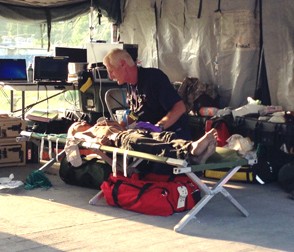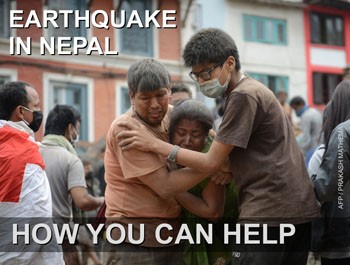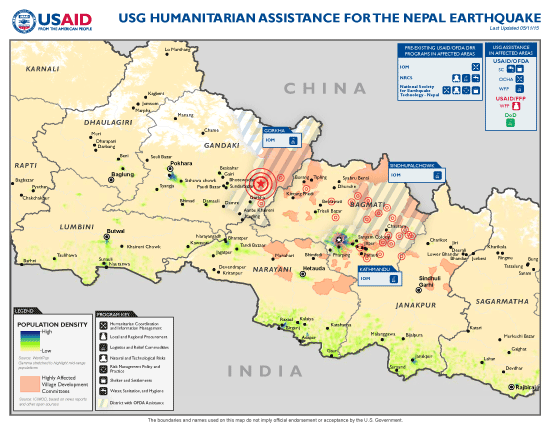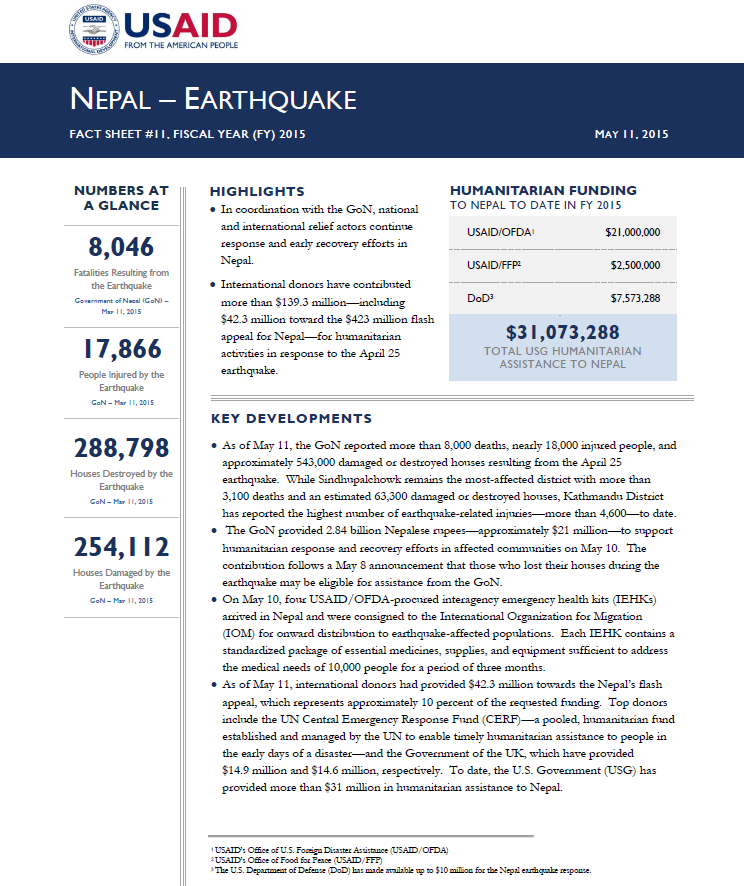Speeches Shim
May 11, 2015
Highlights
In coordination with the GoN, national and international relief actors continue response and early recovery efforts in Nepal.
International donors have contributed more than $139.3 million—including $42.3 million toward the $423 million flash appeal for Nepal—for humanitarian activities in response to the April 25 earthquake.
Key Developments
As of May 11, the GoN reported more than 8,000 deaths, nearly 18,000 injured people, and approximately 543,000 damaged or destroyed houses resulting from the April 25 earthquake. While Sindhupalchowk remains the most-affected district with more than 3,100 deaths and an estimated 63,300 damaged or destroyed houses, Kathmandu District has reported the highest number of earthquake-related injuries—more than 4,600—to date.
Nepal Earthquake Map - May 11, 2015 ![]() (pdf - 873k)
(pdf - 873k)
Numbers At A Glance
8,046
17,866
288,798
254,112
Humanitarian Funding:
To Nepal To Date In FY2015:
| USAID/OFDA | $21,000,000 |
| USAID/FFP | $2,500,000 |
| DoD | $7,573,288 |
| TOTAL | $31,073,288 |
Nepal Earthquake Fact Sheet #11 - 05-11-2015 ![]() (pdf - 201k)
(pdf - 201k)
The GoN provided 2.84 billion Nepalese rupees—approximately $21 million—to support humanitarian response and recovery efforts in affected communities on May 10. The contribution follows a May 8 announcement that those who lost their houses during the earthquake may be eligible for assistance from the GoN.
On May 10, four USAID/OFDA-procured interagency emergency health kits (IEHKs) arrived in Nepal and were consigned to the International Organization for Migration (IOM) for onward distribution to earthquake-affected populations. Each IEHK contains a standardized package of essential medicines, supplies, and equipment sufficient to address the medical needs of 10,000 people for a period of three months.
As of May 11, international donors had provided $42.3 million towards the Nepal’s flash appeal, which represents approximately 10 percent of the requested funding. Top donors include the UN Central Emergency Response Fund (CERF)—a pooled, humanitarian fund established and managed by the UN to enable timely humanitarian assistance to people in the early days of a disaster—and the Government of the UK, which have provided $14.9 million and $14.6 million, respectively. To date, the U.S. Government (USG) has provided more than $31 million in humanitarian assistance to Nepal.
HUMANITARIAN ASSESSMENTS
In coordination with the GoN, the USAID Disaster Assistance Response Team (DART) continues to conduct humanitarian assessments in earthquake-affected communities. On May 9, DART and USAID/Nepal staff assessed Kathmandu’s Sankhu municipality and nearby Naglebhare village. The DART estimates that more than 50 percent of houses observed were damaged or destroyed, with more than 80 percent of houses collapsed in downtown Sankhu. Residents in the assessed areas identified shelter assistance as the priority need, and the DART highlighted debris removal as an additional priority need and a key impediment to recovery efforts.
To address urgent shelter needs, affected households in Sankhu and Naglebhare have begun salvaging construction materials from the debris, including timber, mud bricks, doors, and windows. Some households are using the salvaged materials, along with plastic sheeting received from USAID/OFDA and other humanitarian actors, to build makeshift emergency shelters.
The DART reports that assessed areas maintain adequate access to water supplies; however, people in rural areas reported that landslides have contaminated drinking water sources, requiring residents to boil or chlorinate the water to render it safe for consumption. In addition, the earthquake destroyed many sanitation facilities, resulting in insufficient latrines and bathing spaces and increasing the risk of disease outbreaks. Hygiene and sanitation supplies remain a critical need in the assessed areas, according to the DART.
DART and USAID/Nepal staff—accompanied by Peace Corps personnel—also assessed three villages in Sindhupalchowk on May 9. While the Nepalese Army assisted with the removal of deceased persons immediately following the earthquake, village residents reported receiving little or no additional external assistance. During the May 9 assessment, the DART confirmed that humanitarian organizations have only distributed relief items to roadside areas and that aid was not reaching harder-hit villages in more remote areas.
In the assessed villages in Sindhupalchowk, the majority of people were living next to their destroyed homes, and residents were using tarps and corrugated iron sheeting to reinforce damaged houses or build new shelters, according to the DART. Relatively few shelter kits had reached the hardest-hit areas, and community members reported shelter as an urgent need. Many identified shelter for livestock and storage areas for agricultural products as additional priorities.
On May 10, a second team of DART staff traveled to Sindhupalchowk and met with Save the Children (SC), the Nepal Red Cross Society (NRCS), and community members in Chautara, the administrative headquarters of the district. SC highlighted emergency sanitation support as an additional priority need, noting that 95 percent of latrines sustained earthquake damage.
The DART reports that most households in the visited areas were demonstrating positive self-recovery activities, and a few were in the process of constructing shelters meant to last beyond the upcoming monsoon season. However, the quality of the shelters in the visited areas was generally poor.
HUMANITARIAN ACCESS
Due to access constraints, the humanitarian community has received minimal reporting or assessment data from earthquake-affected areas of northern Gorkha, and limited aid has reached populations in need. As a result, IOM and other relief agencies are using creative methods, such as hiring teams of mountaineers and long-distance runners, to traverse difficult terrain and access populations in remote and hard-to-reach locations.
The Camp Coordination and Camp Management Cluster (CCCM)—the coordinating body for humanitarian CCCM activities, comprising UN agencies, NGOs, and other stakeholders—recently conducted an assessment of Gorkha’s Baluwa village, which experienced significant destruction to houses and public infrastructure during the earthquake. Baluwa serves as a key transit point for relief commodities carried by foot to more northern, mountainous areas. For example, Barpak village development committee (VDC) collects relief supplies arriving from Baluwa for distribution to villages in the VDC’s nine wards, which cumulatively host nearly 2,000 households that are inaccessible by car. Although the Indian Army has conducted ad hoc distributions of relief commodities, including food assistance, in the VDC by air, Nepalese officials report that additional assistance is needed. Baluwa is presently accessible by car, but humanitarian actors report that the impending monsoon season may disrupt road access and further impede relief commodities from reaching remote communities.

DISPLACEMENT
As of May 9, IOM reported nearly 42,000 displaced people located in approximately 90 displacement sites throughout Kathmandu Valley—including an estimated 36,100 people sheltering in 38 open spaces that were previously identified through IOM’s USAID/OFDA-funded Open Spaces project. IOM also identified nearly 5,800 additional people sheltering in 54 spontaneous sites in Kathmandu Valley. In Nepal’s capital city of Kathmandu, approximately 17,100 people remained in 16 formal displacement sites as of May 7—representing a nearly 29 percent decrease since April 30. In Bhaktapur city, Bhaktapur District, nearly 8,200 people were sheltering in 12 displacement sites, while nearly 2,400 people were sheltering in three displacement sites in Lalitpur city, Lalitpur District.
As the humanitarian community transitions out of the initial emergency response phase, the CCCM Cluster plans to assess which sites are suitable for use during the upcoming monsoon season, as some displaced populations will likely need to remain in camp settings.
In high-altitude, earthquake-affected areas of northern Nepal, IOM has received reports that entire villages have had to relocate due to landslides or other environmental instability in their villages; IOM notes that the stability of the terrain in the newly chosen locations remains a concern. In response to a request from local authorities, IOM is identifying and mapping affected villages that may benefit from additional information on the post-earthquake stability of the terrain in areas of origin or new locations.
WASH
Preliminary WASH assessments in affected areas indicate that most of the earthquake related damage to latrines is to latrine superstructures rather than bases; WASH actors need to identify methods to effectively replace or repair superstructures in the early recovery phase.
On May 6, a USAID/OFDA water, sanitation, and hygiene (WASH) advisor arrived in Kathmandu to provide technical expertise to the DART and the greater humanitarian community. Since his arrival, the advisor has met with WASH Cluster actors to discuss priority assistance needs and coordinate response efforts across affected districts.
AGRICULTURE AND FOOD SECURITY
Although the April 25 earthquake destroyed many shops and markets in Sankhu, local residents interviewed during the DART’s assessment did not report access to food as a major concern due to the town’s proximity to Kathmandu and successful efforts to recover household food stocks from collapsed structures. Community members did, however, express concern about livelihoods opportunities, as coping with shelter needs is limiting time available for field labor.
In contrast, residents of Naglebhare reported that some food stocks were stored in buildings that had collapsed, making access to food supplies difficult. However, rice and other food remain available in local markets.
Although most families in the DART-assessed Sindhupalchowk villages reported recovering approximately 50 percent of their household food stocks, many residents expressed concern about storing food stocks, future harvests, and seeds once the monsoon rains arrive.
As of May 8, the GoN Ministry of Agriculture Development had released 90 million Nepalese rupees—or more than $879,000—for the purchase of seed, fertilizer, and animal feed for earthquake-affected populations. Food security actors report that humanitarian agencies may not import or distribute new varieties of seed; only currently registered seed varieties may be brought in from outside of Nepal.
HUMANITARIAN COORDINATION
To facilitate and expand earthquake response coordination, UN Resident and Humanitarian Coordinator for Nepal Jamie McGoldrick appointed two area humanitarian coordinators on May 9 to serve as representatives to local authorities, lead local humanitarian country teams, and facilitate inter-cluster coordination outside of Kathmandu Valley. The Gorkha-based coordinator will cover Dhading, Gorkha, and Makawanpur districts, while the Sindhupalchowk-based coordinator will cover Dolakha, Kavrepalanchowk, Okhaldhunga, Ramechhap, Sindhuli, and Sindhupalchowk districts. Activities in Rasuwa and Nuwakot districts will continue to be coordinated from Kathmandu.
CONTEXT
On April 25, a magnitude 7.8 earthquake struck central Nepal at a shallow depth of approximately 15 kilometers (km), according to the USGS. The epicenter of the earthquake was located approximately 77 km northwest of Kathmandu, the country’s capital city, and 73 km east of Pokhara, another major city in central Nepal.
The USG immediately issued a disaster declaration for Nepal due to the effects of the earthquake. Within hours of the seismic event, USAID/OFDA had activated a RMT in Washington, D.C., and deployed a DART—including USAR specialists—to support emergency response efforts in Nepal.
For nearly two decades, USAID/OFDA has supported disaster risk reduction (DRR) efforts in Nepal, including throughout Kathmandu Valley. USAID/OFDA funding has enabled the International Organization for Migration (IOM) to identify, prepare, and preserve more than 80 open spaces in Kathmandu Valley to ensure the sites are available for humanitarian purposes—such as distribution centers or warehouses—in the event of large-scale disasters. USAID/OFDA has also supported NRCS to pre-position critical emergency relief supplies in order to address the immediate needs of affected communities following a disaster.
Through the Kathmandu-based National Society for Earthquake Technology (NSET), USAID/OFDA is strengthening Nepal’s earthquake response capacity by institutionalizing DRR at the local and national levels in collaboration with the GoN, non-governmental organizations, schools, and local communities. With USAID/OFDA support, NSET is also promoting public-private partnerships for earthquake risk management and enhancing the capacity of municipal governments to develop and administer building code permits and control systems to better protect against seismic activity.
PUBLIC DONATION INFORMATION
The most effective way people can assist relief efforts is by making cash contributions to humanitarian organizations that are conducting relief operations. A list of humanitarian organizations that are accepting cash donations for disaster responses around the world can be found at www.interaction.org.
USAID encourages cash donations because they allow aid professionals to procure the exact items needed (often in the affected region); reduce the burden on scarce resources (such as transportation routes, staff time, and warehouse space); can be transferred very quickly and without transportation costs; support the economy of the disaster-stricken region; and ensure culturally, dietary, and environmentally appropriate assistance.
More information can be found at:
- The Center for International Disaster Information: www.cidi.org or +1.202.821.1999.
-
Information on relief activities of the humanitarian community can be found at www.reliefweb.int.




Comment
Make a general inquiry or suggest an improvement.